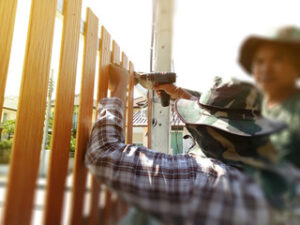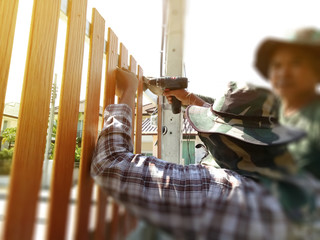Residential Fencing Repair
Fencing is a great way to keep children and pets safe, clearly mark property lines and increase a home’s curb appeal. However, like anything else, it can sustain damage and require repair — and that’s where a professional Pro Angle Fencing Summerville comes in.
 Local laws and ordinances vary, but homeowners insurance generally covers fence repair, though you’ll need to pay your deductible first. Here are some of the most common residential fencing repair jobs:
Local laws and ordinances vary, but homeowners insurance generally covers fence repair, though you’ll need to pay your deductible first. Here are some of the most common residential fencing repair jobs:
As you can imagine, fence post repair costs can vary quite a bit depending on the type and size of the repair and the type of fence. For example, a chain link fence with extensive damage from a storm might require new posts all along its length and cost more to repair than a wooden picket fence with just one broken post. Fence size also matters because the bigger a fence, the more time and material it takes to bring it back to its original condition.
Most wooden fences are fairly easy to repair. Holes caused by insects and weather can be filled with putty, and boards replaced so they match up evenly. However, sometimes a damaged wooden fence post can indicate more serious issues like rot below ground or erosion of the post hole. Replacing a wood fence post requires digging a hole equal to half the above ground height of the old post and then digging it in place, using concrete to ensure the post is secure.
The metal brackets that hold the rails of a split-rail fence fit into holes in the posts. If a split-rail fence post rots or otherwise needs to be replaced, remove the remaining rail from the other side of the fence and replace the screw in the post with a new one, then set a replacement split-rail fence post by cutting it to the proper length and fitting it in its place. Once the new split-rail fence post is in place, slip its railings onto the post.
A wood fence with 4×8 panels is more difficult to repair than a split-rail fence, but it’s still possible to do it yourself. First, screw blocks of wood to the posts on either side of a damaged panel. Then, with a reciprocating saw, cut the screws holding the panel to its neighbors and let it fall down onto the blocks. Screw a replacement panel to the same block positions, and attach it to its rails with new screws.
Most boundary fences are on a property line, and therefore, the owners of each piece share responsibility for maintaining and repairing the fence. Clear communication with your neighbor is important, and it’s a good idea to review local laws and ordinances online or over the phone to make sure you have all of the information necessary to resolve any disputes about fence maintenance and repairs.
Panel Replacement
Fences do a lot of work for homeowners – they keep children and pets safe from wandering traffic, add curb appeal to a property and are great for keeping out trespassers. But they also take a beating from the elements and need regular care and maintenance to function properly.
The most common residential fencing repair is replacing damaged or missing fence panels or slats. This can be caused by severe weather, aging, or from the fence being hit by a vehicle or other object. Depending on the materials used in the fence, and the size and height of the panel or slat, replacement costs can range from $150 to $400.
Replacing a fence panel is relatively simple, though it does require accurate measurements and a level of skill. The first step is to remove the old panel from the post, then measure each end of the posts to ensure that the new panel will fit. Using the measured dimensions, the contractor can cut and screw in the new panel and finish with a coat of stain or paint to match the rest of the fence.
Wood rot is a common issue that can affect individual fence planks, or slats. If the slat is still in good shape but has been pulled loose from its stringers, the contractor can use new fasteners to re-attach it. Fence planks can also break if struck by a vehicle or other force, or from the pressure of pets pushing and biting on them.
When the bottom rail of a chain link fence is bent, it can be replaced by using linesman’s pliers to remove the ties and a reciprocating saw to cut both ends of the bent section of the rail. A coupling sleeve can then be slipped on the ends of the new railing to secure it in place.
Post replacement costs are typically higher than those for other types of residential fencing. This is because a hole needs to be dug for each post and the concrete must set before the fence can be safely supported on its foundation.
Staining or Painting
Staining and painting are popular ways to improve the look of a fence. Both provide a protective coating and protect against environmental factors like rain, snow and the sun. Choosing between stain and paint will depend on the homeowner’s personal preference. The key is to choose a high-quality paint or stain that will not be easily scratched and can withstand the elements of weathering. The cost of the paint or stain will also play a role in the choice made.
The cost of a paint job will be higher than the cost of a stain, depending on how long the fence is and the sheen level that is chosen. Professional painters typically charge per linear foot or square foot, and their labor costs will also be factored into the total cost of the project. Handy homeowners can save money by completing the stain or painting process themselves.
When choosing between a stain and paint, keep in mind that the stain will not need to be reapplied as frequently as a paint coat. However, the stain will need to be reapplied every two or three years to keep it looking fresh.
One of the main advantages to staining is that it will not chip or crack as easily as paint and will allow the natural beauty of the wood to show through. Additionally, stains come in many different shades that can be used to complement the aesthetic of any home.
As a result, stain is often the preferred option for homeowners looking to make their fence stand out from the rest of the neighborhood. The only downside to staining is that it does not offer the same contrasting color options as latex paint, so homeowners may be limited in their selections when choosing to stain.
Stain can be more expensive than paint at the start, but it requires less maintenance in the long run. The reason for this is that stain absorbs much more deeply into the surface of the wood than a coat of paint. The deeper treatment will help the stain last longer, meaning that you will not need to repaint your fence as regularly as if it was painted.
Boundary Adjustment
A boundary line adjustment, also known as a lot line adjustment, is similar to a subdivision in that the boundary lines between two adjacent landowners are being changed or adjusted. However, the key difference lies in jurisdiction and purpose. When a boundary line adjustment is sought, the jurisdiction rests with the local planning authority, usually the city or county in which the property is located. This means that there is an application process, review fees and the requirement to meet the approval criteria of the reviewing agency.
Generally, a boundary line adjustment will result in a transfer of a small amount of land between the owner of one parcel and the owner of another. The purpose of a boundary line adjustment is to resolve conflicting property lines or encroachments. Generally, the resulting boundary line will be moved a short distance, not to exceed 10% of the existing land area.
For example, a common reason for boundary line adjustments is the location of a driveway, which may have been placed in a position that causes an encroachment on the neighbouring property. This situation can be resolved by having a professional surveyor perform a boundary line adjustment to correct the encroachment and create a new recordable corner in the county record of surveys.
The other reason for a boundary line adjustment is to change the acreage of the property, in order to be taxed at a different rate or for purposes of estate planning. This is accomplished by having a professional surveyor prepare and record a deed for the new acreage. The newly recorded deed must be provided to the County Assessors in order for the change to take effect.
As with any planning board decision, a boundary line adjustment can be appealed by any party-of-record during the 14-day appeal period after the approval is granted. If an appeal is successful, the approval will be revoked. Therefore, it is important that any parties considering a boundary line adjustment record all associated deeds and maps before the one-year approval period expires. If not, the approval will lapse and the property will continue to be taxed based on its previous acreage.


